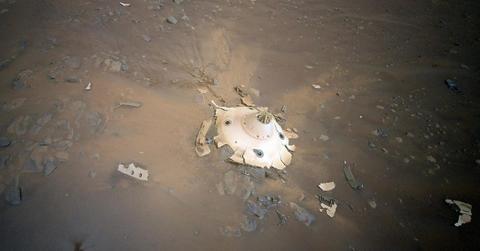Alien Invasion? NASA Spacecraft Captures 'Otherworldly' Wreckage on Mars

NASA's Ingenuity helicopter has photographed some "otherworldly" images of wreckage on Mars.
NASA's Ingenuity helicopter, nicknamed the "Marscopter," recently captured “otherworldly” images of what appears to be extraterrestrial wreckage on Mars that resembles a scene from a science-fiction film.
The photos reveal remnants of what appears to be an alien spacecraft.
Ingenuity, a companion to the Perseverance rover, photographed the wreckage while traversing the rover's landing site on its way to a river delta.
The debris, however, is a backshell, the upper portion of the landing capsule that transported both the Perseverance rover and the Ingenuity helicopter to Mars.
The landing capsule served as a protective shield for the rover and its companion during their entry into Mars' atmosphere in 2021.
The images captured by NASA's helicopter show the 70-foot-wide parachute, used to slow down the vehicle's descent, still attached to the backshell. Vehicles entering Mars' atmosphere must endure extreme temperatures while hurtling towards the surface at speeds nearing 12,500 miles per hour, according to Express.
The New York Times reported that the parachute and backshell detached from the rover and helicopter at a height of 1.3 miles, landing over a mile away from the Perseverance rover and partially shattering in the process. The rover and helicopter were safely delivered to the surface using a rocket-powered system known as Skycrane.
"There’s definitely a sci-fi element to it... It exudes otherworldly, doesn’t it?" said Ian Clark, an engineer involved in Perseverance's parachute system, The Times reported.
- Picture Perfect: Mars Helicopter Hovering 39 Feet Over Red Planet Captures Stunning Image of Martian Landscape
- Mission Unaccomplished: Peregrine Spacecraft's Journey to Moon Lost in Space, Has 'No Chance’ of Landing
- Lost in Space? Peregrine Spacecraft Scheduled for Moon Landing Now Orbiting Without Definitive Resolution
Clark highlighted that while Perseverance's landing was extensively documented, Ingenuity's images provide a unique perspective.
As reported by the Express, Clark expressed optimism about the potential value of the images for future Mars missions, stating, "If they either reinforce that our systems worked as we think they worked or provide even one dataset of engineering information we can use for Mars Sample Return planning, it will be amazing. And if not, the pictures are still phenomenal and inspiring."
Never miss a story — sign up for the Front Page Detectives newsletter. Be on the scene the moment news breaks.
The Times emphasized the significance of studying the backshell remains for the upcoming "Mars Sample Return" mission, which aims to retrieve rocks and soil from Mars for in-depth analysis on Earth.
That mission involves deploying two landers — a rover to collect rock samples drilled by Perseverance and a small rocket to launch the samples into orbit for retrieval by another spacecraft.
The wreckage, strategically located between the Seitah and Maaz rock formations in the crater formed during the Perseverance rover's 2021 landing, holds potential insights for scientists.
Kenneth Farley, the project scientist of the mission, noted: "Remarkably, this wreckage wound up right on the contact between the two rock formations on the crater floor."
Become a Front Page Detective
Sign up to receive breaking
Front Page Detectives
news and exclusive investigations.
